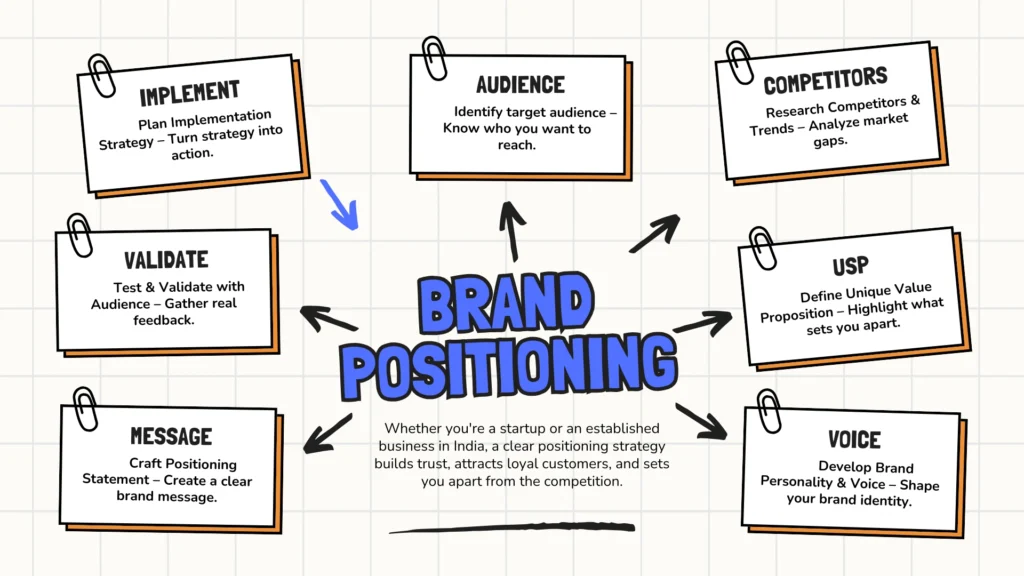Importance of Positioning in Marketing for Business Growth

If you had to sum your business up in one sentence, what would that be?
And more importantly, what would your customers say it is?
That’s what brand positioning is, developing a singular identity in the mind of your customer.
It’s not a buzzword for marketing people; it’s what gets people to choose one brand over another when the products are essentially the same.
This blog will simplify the significance of market positioning, so you can see why it’s necessary and how you can implement it in your own business.
What is Brand Positioning?
Fundamentally, brand positioning addresses three easy questions:
- Who are you working for? (Your target market)
- What are you uniquely different at? (Your differentiation)
- Why should customers choose you? (Your competitive edge)
Customers are bombarded with options daily.
If your company doesn’t differentiate, you become just one more option among many.
That’s where market positioning comes in.
It enables you to develop a clear and compelling identity that resonates directly with your ideal customers.
When executed correctly, positioning drives everything from pricing and messaging to customer loyalty and long-term growth.
When you position yourself correctly, customers don’t simply purchase from you; they remember you.
It influences their mindset about your brand, drives buying behaviour, and creates long-term loyalty.
Regardless of whether you wish to be recognized for low prices, high quality, innovation, or something else, your brand positioning will determine how you differentiate in the saturated Indian market.
Bases of Positioning in Marketing
What do you actually position on? Here are the most important approaches:
- Product Features & Benefits – Emphasizing what differentiates your product or service, such as higher quality, groundbreaking features, or extra benefits that others don’t provide.
- Price & Value Proposition – Position your brand as affordable or luxury, based on whether affordability or exclusivity is your priority.
- Usage & Experience – Building an identity around when and how your product is used, positioning it as the default solution for particular needs or lifestyles.
- Customer Demographics – Addressing a specific group by age, location, income, or interests to make your brand more appealing and relatable.
- Emotional Connection – Appealing to customer emotions, values, or ambitions to establish long-term trust and loyalty.
All these bases contribute to how your brand is perceived by customers.
The trick is selecting a method that appeals to your target market without compromising your brand’s strengths.
A solid brand positioning makes you memorable for the right reasons, and it is easier to compete in a competitive market.
Why Brand Positioning is Important for Small Businesses
For small businesses, differentiation is not a choice, it’s a necessity.
You’re not only competing with local players but also with big brands that have deeper pockets and better distribution channels.
That’s where brand positioning is your ace in the hole.
It allows you to create a niche, get the right customers, and establish a loyal following without getting lost in the fray.
Consider Zudio, for instance. Rather than yet another clothing chain, it established itself as the affordable, style-conscious label whose fashionable offerings appeal to masses rather than only being a trendy product.
Or Nykaa, which isn’t merely a site for purchasing cosmetics online.
It has crafted a persona for itself as that go-to guru on beauty and health, who retails exclusive groups, professional guides, and collaborative shopping models.
And then there’s Old Monk, a brand that is more than just another rum.
It has emerged as an iconic, nostalgia brand, founded on tradition, loyalty, and cult status that eschews fashions in favour of traditions.
These companies don’t merely sell products; they sell a mood, a way of life, and a special sense of identity.
For small businesses, effective positioning can:
- Enable customers to immediately know what you’re about.
- Make your brand memorable and gain trust.
- Justify premium pricing if you’re creating something unique.
- Minimize marketing costs by attracting the right audience organically.
Unless you have a strong positioning, your business is just another name in a competitive market.
But with the correct strategy, you can make your brand the number one choice among your ideal audience, regardless of how large or small your competition is.
PhonePe vs. Google Pay vs. Paytm
PhonePe, Google Pay, and Paytm are all part of the same UPI ecosystem, but each one of them has taken a different approach to winning users.
PhonePe established itself as a bank-first UPI platform, focusing on trust, frictionless transactions, and integrations with banks deep down.
Google Pay, however, followed a different strategy, and it positioned itself as the simplest and most rewarding method of sending money.
With the help of easy onboarding, a user-friendly interface, and attractive cashback rewards, it gained a huge user base in no time.
Paytm, however, extended itself beyond payments.
It established itself as a super app, providing everything ranging from UPI transactions to mobile recharges, booking tickets, and financial services under one umbrella.
Even though they are in the same market, all brands have produced a different space in consumers’ minds.
Instamart vs. Blinkit vs. Zepto
Although all three are about quick grocery delivery, each of them appeals to the customer differently.
Instamart, which is funded by Swiggy, has positioned itself as a safe and convenient addition to food delivery.
By plugging into Swiggy’s network, it goes after existing customers who want both meals and groceries delivered quickly.
Blinkit (previously Grofers) went the other way, focusing on being the first choice platform for instant necessities, highlighting quickness and availability of products.
Its rebranding to Blinkit further reiterated the assurance of near-instant delivery, hence becoming the first choice for the need for things in a hurry.
Zepto pioneered the market with a bold 10-minute delivery guarantee, which placed it in the position of being the quickest grocery delivery company.
This extremely quick delivery made it different from the rest and attractive to urban consumers who seek instant gratification.
All of these brands offer the same service but are seen differently because of deliberate brand positioning.
Tata 1mg vs. Apollo Pharmacy
Tata 1mg and Apollo Pharmacy have taken different stances, targeting different kind of customers.
Tata 1mg has emphasized being a comprehensive digital healthcare platform, providing not only medicines but also laboratory tests and consultations from doctors and physicians.
Positioning itself as an end-to-end solution for online healthcare, it tends to attract those seeking a complete medical experience.
Apollo Pharmacy, with the support of the Apollo Hospitals brand, has established itself as the most reliable and convenient pharmacy chain.
Its extensive offline reach and image in healthcare put it ahead when it comes to reliability, as people who rely on established medical centers tend to prefer it.
Steps to Create a Strong Positioning Strategy
Crafting a strong positioning strategy is not merely a matter of finding the right words but is actually a way to shape perceptions so customers see your brand as you would have them. Here’s how you do it:
- Know Your Target Customer – Research who your ideal customer is, what that person needs, and what, ultimately, they purchase.
- Analyze Your Competitors – Investigate how others are positioning themselves in your industry and look for gaps your brand can fill.
- Develop Your Unique Value Proposition – Clearly define what differentiates your product or service and why customers should choose your product over the competition.
- Create a Clear Positioning Statement – Distill your brand’s point of difference in one, motivating sentence that determines the tone of all your marketing campaigns.
- Link Branding & Messaging – Ensure your logo, brand’s tagline, website, and marketing materials uniformly echo your positioning.
- Test & Refine – Positioning isn’t fixed. Get customer insights, observe market trends, and fine-tune your strategy where necessary to remain contemporary.
A clearly defined positioning strategy not only attracts the appropriate customers but also enhances brand loyalty.
Final Thoughts
Positioning in marketing is the most crucial aspect.
Without positioning, you risk becoming another face in the crowd and missing opportunities for growth. Take the time to define what makes your brand unique.
Focus on what you offer, who you serve, and why it matters.
Disclaimer: The information contained in this blog, The Growth File, is intended for general informational purposes only and does not constitute professional advice. Always consult with a qualified professional before making any business decisions based on the information you find on this blog.
What’s New?
-
Over 250 Indian Brands Tagline That Left a Mark
Marketing -
13 Dairy Business Ideas with Strong Demand
Business Ideas -
Effective Marketing for Local Businesses in FMCG
Marketing -
14 Steel Business Ideas in India for Small and Medium Enterprises
Business Ideas -
13 Pharma Business Ideas with High Margin Potential
Business Ideas

